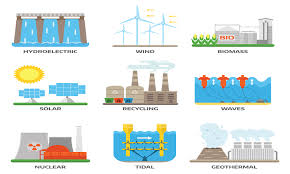Exploring Green Energy Examples
Green energy, also known as renewable energy, is derived from natural sources that are constantly replenished. This type of energy production is sustainable and has a lower environmental impact compared to traditional fossil fuels. Let’s explore some common examples of green energy:
Solar Power
Solar power harnesses energy from the sun using photovoltaic cells to convert sunlight into electricity. Solar panels can be installed on rooftops or in solar farms to generate clean and renewable energy for homes, businesses, and communities.
Wind Power
Wind power utilizes wind turbines to capture the kinetic energy of the wind and convert it into electricity. Wind farms located in windy regions can produce significant amounts of green energy to power homes and industries.
Hydropower
Hydropower generates electricity by harnessing the energy of flowing water. Dams and hydroelectric power plants use water flow to turn turbines and generate clean, renewable energy. Hydropower is a reliable source of green energy in many regions around the world.
Biomass Energy
Biomass energy is produced from organic materials such as wood chips, agricultural residues, and waste biomass. These materials can be burned or converted into biogas to generate heat or electricity. Biomass energy helps reduce waste while providing a sustainable source of power.
Geothermal Energy
Geothermal energy taps into heat stored beneath the Earth’s surface to produce electricity and heat buildings. Geothermal power plants use steam or hot water from underground reservoirs to drive turbines and generate clean, renewable energy with minimal environmental impact.
These are just a few examples of green energy sources that are helping reduce carbon emissions and combat climate change. By investing in renewable technologies and transitioning away from fossil fuels, we can create a more sustainable future for generations to come.
5 Practical Tips for Embracing Green Energy at Home
- Consider installing solar panels on your roof to harness the power of the sun for electricity.
- Use energy-efficient LED light bulbs to reduce electricity consumption and lower your carbon footprint.
- Invest in a programmable thermostat to optimize heating and cooling in your home for energy savings.
- Support renewable energy sources like wind farms or hydroelectric power by choosing green energy providers.
- Reduce water heating costs by using a solar water heater or investing in an energy-efficient heat pump.
Consider installing solar panels on your roof to harness the power of the sun for electricity.
Consider installing solar panels on your roof to harness the power of the sun for electricity. Solar panels are a great example of green energy technology that can help reduce your carbon footprint and lower your reliance on traditional energy sources. By capturing sunlight and converting it into electricity, solar panels not only provide a renewable energy source but also offer long-term cost savings and environmental benefits. Embracing solar power is a sustainable choice that can contribute to a cleaner and greener future for our planet.
Use energy-efficient LED light bulbs to reduce electricity consumption and lower your carbon footprint.
By incorporating energy-efficient LED light bulbs into your home or workplace, you can significantly decrease electricity consumption and lessen your carbon footprint. LED bulbs consume less energy than traditional incandescent bulbs, resulting in reduced electricity bills and environmental impact. Making the switch to LED lighting is a simple yet effective way to contribute to a more sustainable future while enjoying long-lasting, cost-effective illumination.
Invest in a programmable thermostat to optimize heating and cooling in your home for energy savings.
Investing in a programmable thermostat is a smart way to optimize heating and cooling in your home for energy savings. By programming your thermostat to adjust temperatures based on your schedule, you can ensure that your heating and cooling systems operate more efficiently, reducing energy consumption and lowering utility bills. With a programmable thermostat, you can create personalized temperature settings for different times of the day, allowing you to stay comfortable while minimizing energy waste. This simple upgrade not only helps you save money but also contributes to a greener environment by reducing your home’s carbon footprint.
Support renewable energy sources like wind farms or hydroelectric power by choosing green energy providers.
Supporting renewable energy sources like wind farms or hydroelectric power is crucial for transitioning to a more sustainable energy future. One way to contribute to this effort is by choosing green energy providers that prioritize renewable sources in their energy generation. By opting for green energy plans, consumers can help drive demand for clean and environmentally friendly electricity, encouraging the growth of renewable energy infrastructure and reducing reliance on fossil fuels. Making the switch to green energy providers is a simple yet impactful step individuals can take to support the transition to a greener and more sustainable energy grid.
Reduce water heating costs by using a solar water heater or investing in an energy-efficient heat pump.
To reduce water heating costs and lower energy consumption, consider utilizing a solar water heater or investing in an energy-efficient heat pump. Solar water heaters harness the power of the sun to heat water, providing a sustainable and cost-effective alternative to traditional heating methods. On the other hand, energy-efficient heat pumps utilize ambient air or geothermal heat to efficiently heat water, offering long-term savings and reduced environmental impact. By implementing these green energy solutions for water heating, you can not only save money but also contribute to a greener and more sustainable future.

